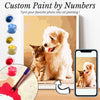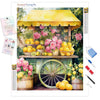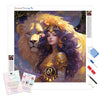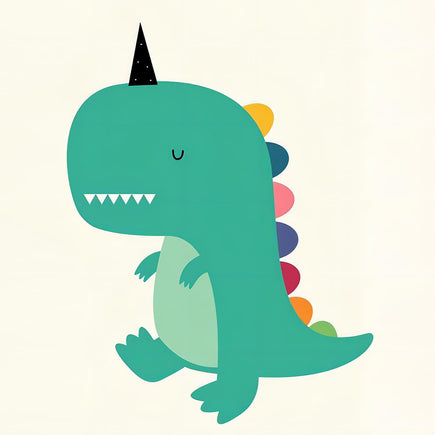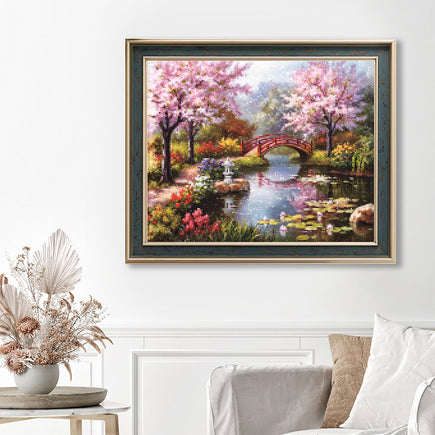5 Easy Methods to Fix Stuck Diamond Painting Drills

Has it ever happened that you opened a bag of diamond painting drills and found some clumped up? Don't you worry! In this tutorial, we will share five easy tricks that will have those beads separated and ready in an instant. With our detailed step-by-step solutions, you will be back to diamond art painting in no time!
Why Do Diamonds Stick Together?
Diamonds or drills tend to clump up due to static electricity or because of the way they are manufactured, packaged, and stick together. Flat sides and small facets of the drills contribute to friction, creating clumps that may be a bit of a pain to use. This is particularly a problem during the dry, colder months where static electricity is really rampant.
Method 1: Use a Pill Bottle or Plastic Container
One of the simplest and most effective methods for separating sticking diamonds is to use a small container, such as an empty pill bottle or a plastic storage container. Here's how to do it:
- Transfer the Diamonds: Pour the clumped diamonds into a small pill bottle or a plastic container with a secure lid.
- Shake Vigorously: Seal the lid tight and begin shaking the container vigorously for about 30 seconds. The shaking motion will help the diamonds separate from each other through the collisions with the sides of the container.
- Check the Results: Carefully open the container and closely examine the diamonds. If they are still clumping together, repeat the process of giving them vigorous shakes. Usually, a few shakes will break up even the most persistent clumps without any problem.
This is an awesome way, as it requires no special equipment, just items you can find in your household.

Method 2: Use a Toothpick or Tweezers
If you have a small number of diamonds stuck together, you might prefer a more hands-on approach:
- Spread Out Diamonds: Gently spread out the diamonds on a clean, flat surface like a plate or tray. Make sure the diamonds are evenly spread.
- Start Separating: Carefully separate the drills using either a toothpick or even better—a pair of tweezers. This method is precise but slightly time-consuming, so it is best suited for smaller clusters.
- Apply Pressure: Use light pressure when prying them apart. Be careful not to use too much force, which may cause the drills to chip or damage.
Method 3: Use a Baggie and Rolling Pin
Use a resealable bag and a rolling pin to separate stubbornly clumped diamonds. Here's how:
- Put the Diamonds in a Bag: Transfer the static diamonds into a resealable baggie.
- Use a Rolling Pin: Place the baggie on a flat surface. Use a rolling pin to roll over the baggie, applying firm pressure gently. It may create quite a bit of noise, but it will help break the diamonds apart. Be cautious, as excessive force could potentially damage the drills.
- Reduce Static with a Buffer: If the rolling causes static cling, place a small dryer sheet inside the baggie to help reduce the static.
Method 4: Use a Dryer Sheet
A dryer sheet may also help absorb static electricity, which often is the source of the sticking problem. Here's how to use it:
- Cut a Small Piece of Dryer Sheet: Take a dryer sheet and cut off a small piece, approximately one to two inches in size.
- Add the Dryer Sheet to Your Container: Place the cut piece of dryer sheet into the container that holds the clumped drills.
- Shake or Let It Sit: Close the lid of the container and shake it or let it sit for a few minutes. The dryer sheet will help neutralize the static electricity, making it easier to separate the drills.
This method is particularly effective for managing static cling and is an excellent solution if you frequently encounter this issue.
Method 5: Use a Bead Separator Tool
Investing in a beads separator tool may be good if many drills clump together. Here's how to use it:
- Transfer Diamonds to the Separator: Begin by pouring the diamonds into the beadseparator, specifically designed to help separate tiny beads or gems.
- Twist the Tool: Many bead separators have twisting or shaking mechanisms. Follow the instructions to twist or shake the tool, which will help break apart the clusters of diamonds with minimal effort. Take care not to use excessive force, as it could harm the drillfacet
- Check for Stubborn Clumps: After using the separator, some diamonds may still be stuck together. These can easily be separated by hand once most of them have loosened.

Additional Tips for Preventing Drills from Sticking
- Avoid Overcrowding: When storing your drills, do not overcrowd them in their storage containers. Overcrowded drills are more likely to clump together.
- Use Dryer Sheets: Place a small piece of dryer sheet or tissue paper in your storage containers at the beginning of preparation to help prevent static buildup. This can greatly reduce the chances of your drills sticking together.
- Control Humidity: Store your diamonds in a room with balanced humidity. Dry environments can increase static electricity, thus for the diamond drills to be more prone to stick together.
Reclaim the fun and creativity of diamond painting!
Sticking is the most prevalent problem with diamond painting; it doesn't have to slow you down. With just a few simple tricks involving things like a pill bottle, tweezers, dryer sheets, or a bead separator, those stuck diamonds are out in no time and ready to shine. Success is all about patience, a little creativity, and trying different methods to see what works best.
Now that your drills are free and ready to go, it's time for you to dive into the fun and creative process of diamond painting. Say goodbye to frustration and hello to endless crafting! Happy Diamond Painting!


